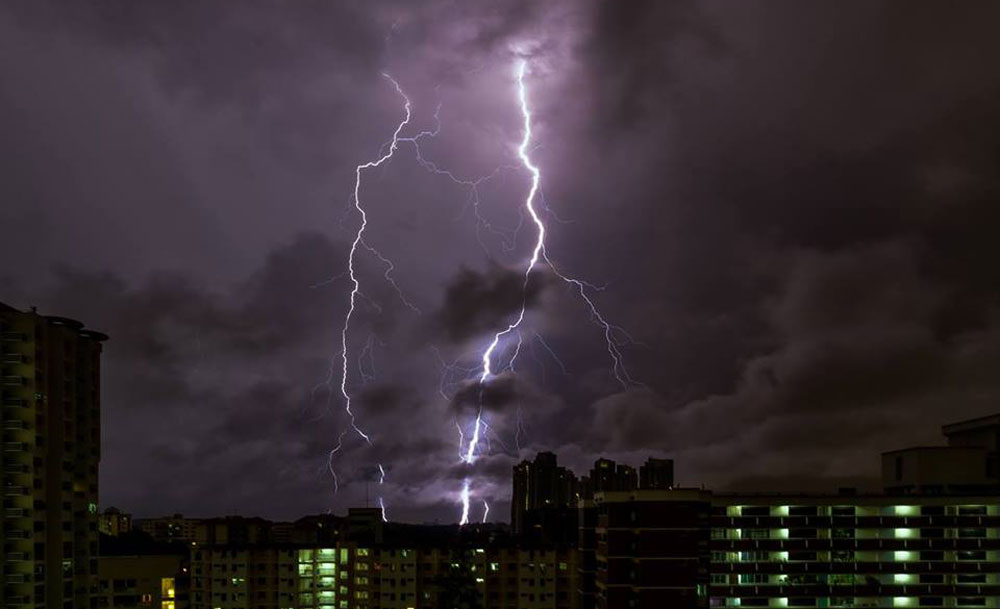Getting struck by lightning in Singapore carries more than one meaning.
There is the avoidable kind and then there is the unavoidable kind.
This article is about the avoidable kind.
Lightning capital in the world
Singapore has anywhere between 171 and 186 lightning days on average a year. Each square kilometer of land in Singapore can be struck up to 16 times annually.
April, May and November are the most lightning-prone months as a result of the intense inter-monsoon conditions.
This makes us effectively one of the lightning capitals of the world.
Lightning strikes and the damage caused
How frequent and damaging are lightning strikes in Singapore?
More often than not, they are not potent or fatal as Singapore is generally well-protected from lightning.
On average, there are 0.35 lightning deaths per million people each year in Singapore. This is in comparison to 0.2 in Britain and 0.6 in the United States.
An average lightning strike carries a current of up to 200,000 amps. In comparison, a 100-watt bulb carries a current of about 0.4 amp.
Which explains why wearing rubber shoes as a form of lightning-protection insulation might be a myth as it would not even help when the current is so strong.
[related_story]
Incidents of lightning strikes
A delay in MRT service between Tanah Merah and Paya Lebar occurred on Monday, Nov. 20, at around 4pm. The disruption has been attributed to a lightning strike near or on the East-West Line around Bedok MRT station.
The Meteorological Service Singapore confirmed a lightning stroke was detected near Tanah Merah MRT station at 3.37pm on Monday.
A year ago, a lightning strike during a heavy thunderstorm was suspected to have crippled an SMRT train on May 11, 2016, which resulted in a bit of an inconvenience for commuters.
The last time fatal lightning strikes made the news was several years ago.
In 2008, a couple was struck by lightning off Punggol jetty in the afternoon. Both appeared to have survived.
In 2011, one man was not so lucky as he was killed and his companion injured after lightning struck them while canoeing in the afternoon at Pasir Ris Park.
Precaution
As Singapore is exposed to the elements and inclement weather all year round, we enforce very stringent codes for lightning protection. Most public places in Singapore are protected.
For example, devices are fitted to the top of floodlight towers at stadiums, while public pools are equipped with lightning rods.
Buildings, observation towers and other structures meant to house people are also shielded from lightning by law. Gazebos in parks, for example, have metal roofs and are "earthed" with thick metal strips to make them lightning-proof.
But when lightning does strike, it can be safely ignored, as in this case, where the Singapore Flyer was hit by lightning:
" frameborder="0" allowfullscreen>
And if there is damage done to public property, it is more of an inconvenience.
For example, in 2009, the Merlion statue in Marina Bay was hit sometime between 4pm and 5pm. There were no reported injuries but the lightning strike created a hole the size of the football and required the attraction to be closed for a few days for repair work to be carried out.
Live information about lightning and rain activity over Singapore is available at the Meteorological Service Singapore website.
What to do when outdoors
In general, there is no safe place outdoors when a thunderstorm is nearby and there is lightning.
The National Environment Agency gives the following advice:
• Take shelter in a house, large building or car and remain inside for at least 30 minutes after the last sound of thunder is heard
• If no structure is available in open areas, head for the lowest elevation and crouch down as low as possible, supporting yourself on the balls of your feet with heels touching (Lightning Crouch position).
• In open water, head for the shore immediately
• Stay off bicycles, motorcycles or golf carts
• Avoid large, open areas and high ground
• Spread out if in a group
• On a golf course (without any nearby shelter), put down your clubs, take off spike shoes and adopt the lightning crouch position
• Stay away from isolated tall objects such as trees, towers or poles
• Stay away from metal conductors such as fences, pipes and rails
• Do not hold metal objects such as golf clubs, umbrellas or bicycles
• Do not handle explosive or inflammable materials
Top photo via
If you like what you read, follow us on Facebook, Instagram, Twitter and Telegram to get the latest updates.
